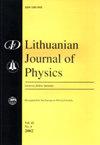在 GEANT4 工具包中对质子反向散射光谱进行数值模拟
IF 0.3
4区 物理与天体物理
Q4 PHYSICS, MULTIDISCIPLINARY
引用次数: 0
摘要
卢瑟福背散射光谱(RBS)是一种广泛应用于原子尺度分析样品成分、晶格位移和杂质剖面的技术。RBS 基于入射带电粒子对靶核的弹性散射以及随后对散射粒子的检测。然而,由于峰值重叠(对应于不同原子种类的散射)以及能量损失、散射几何形状和探测器响应的不确定性,RBS 光谱的解读面临挑战。为解决这一问题,我们开发了基于通用 GEANT4 仿真工具包的开源仿真模型。开放源代码的灵活性使用户能够根据自己的具体要求定制模型,例如使用特定的粒子停止功率、截面和物理过程。这项工作展示了在随机取向条件下,晶体硅、碳化硅和二氧化硅样品在 1-2.5 MeV 能量质子作用下的实验和模拟反向散射光谱的比较结果。结果表明,该模型能够准确模拟无定形材料和单晶体的反向散射光谱。模拟结果与实验结果之间的整体一致性非常有利于未来的发展,并可用于解释和模拟 RBS 光谱。本文章由计算机程序翻译,如有差异,请以英文原文为准。
Numerical simulation of proton backscattering spectra in GEANT4 toolkit
Rutherford backscattering spectroscopy (RBS) is a widely used technique for the atomic-scale analysis of sample composition, lattice displacement and impurity profiling. RBS is based on the elastic scattering of incident charged particles by target nuclei and the subsequent detection of scattered particles. The interpretation of RBS spectra, however, poses challenges due to overlapping peaks, corresponding to scattering from different atomic species, and uncertainties from energy loss, scattering geometry and detector response. To address this, an open source simulation model based on the versatile GEANT4 simulation toolkit has been developed. The flexibility of the open source enables users to tailor the model to its specific requirements, such as the use of specific particle stopping powers, cross-sections, and physics processes. This work presents the results of the comparison between the experimental and simulated backscattering spectra in crystalline silicon, silicon carbide and silicon dioxide samples by 1–2.5 MeV energy protons, obtained in random orientation conditions. The results demonstrate the capability of the model to accurately simulate backscattering spectra in both amorphous materials and single crystals. The overall agreement between the simulated and experimental results is highly promising for future development and use in the interpretation and simulation of RBS spectra.
求助全文
通过发布文献求助,成功后即可免费获取论文全文。
去求助
来源期刊

Lithuanian Journal of Physics
物理-物理:综合
CiteScore
0.90
自引率
16.70%
发文量
21
审稿时长
>12 weeks
期刊介绍:
The main aim of the Lithuanian Journal of Physics is to reflect the most recent advances in various fields of theoretical, experimental, and applied physics, including: mathematical and computational physics; subatomic physics; atoms and molecules; chemical physics; electrodynamics and wave processes; nonlinear and coherent optics; spectroscopy.
 求助内容:
求助内容: 应助结果提醒方式:
应助结果提醒方式:


